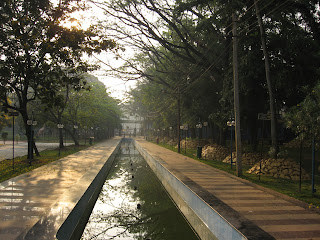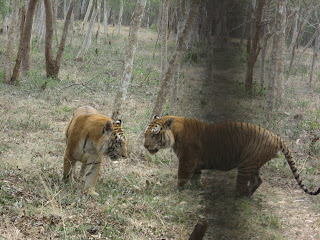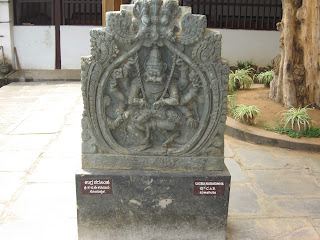In Shimoga, now on the way to become Shiva Mogga, in Karnataka last week.
It is the district head quarter of the district of the same name. Shimoga was historically the southern tip of Emperor Ashoka's Mauryan empire in the 3rd century, then was part of the Kadamba empire (4th century), the Chalukyas (6th century), Gangas, Rashtrakutas (8th century), Hoysalas (11th century), Vijayanagara (15th century) and got its independent identity under the Keladi Nayaka rule. From late 17th century it was part of the Mysore empire until it merged into the Republic of India. The town is rather small, has several educational institutions, engineering and medical colleges, hospitals, and much more. There are fresh fruits everywhere, sugarcane and paddy fields line the roads and the ubiquitous temples, mosques and churches are seen in plenty as in all Indian towns. But what Karnataka brings is the old-world buildings that it has preserved, be it colleges, homes, temples, schools and it gives every town in Karnataka a whiff of the mythical Malgudi that R.K. Narayan has created for us.
I walked about the streets as I normally do, found a nicely maintained park that seems to be quite popular going by the number of people who come there. It has a walking track, a jogging track, a jungle gym, a toy train, lawns, water bodies, a nice garden, places to sit under tall, shady trees, gazebos, places to play and much more.
Entry is free which was surprising since we are used to paying for everything in Hyderabad.
A walk further down the road took me to an imposing church, the Sacred Hearts Church and I visited it.
Further along I found temples and the path that leads to the river Tunga which flows by the town (it meets river Bhadra later which flows through the Bhadravati town and becomes Tungabhadra). I found an old, old post office which must have been around from the days of the British, old houses and colleges.
The fishermen used coracles in the river.
I saw an old cafe. Krishna cafe and stopped by for a cup of coffee and started chatting with the manager Mr. Balakrishna Nayak.
He told me that the cafe was started in 1933 and is now 80 years old. It has lost a bit of its frontage due to road widening but still has the aura of the Boardless cafe that is described in Malgudi books.
Though Mr. Nayak told me about their famous dosas I could not go back there to taste them. The coffee was excellent. I loved the way he would play suprabhatam in the mornings, the smell of agarbattis and fresh coffee. Brilliant stuff.
Riaz and I went to the lion safari near Tyavarekoppa. It is a nice place with a small zoo that has leopards, panthers, bears, python, birds, tiger and lion safaris. The zoo is small as far as animals are concerned but it covers a large area for the safari bits.
We saw the tiger safari and were suddenly witness to two full grown tigers fighting with one another, standing on their hind legs, eyes locked, growling at one another and roaring in that deep, majestic manner of theirs. It's certainly worth a visit, this safari.
One another day I went to the Shivappa Naik palace in the town. Once again there was no charge, not even the Rs.2 that some places here charge.
It is well kept and maintained and some rooms are used as offices for the archaeology department. There are security guards. Inside the palace there is a museum of sorts where manuscripts of all the Hindu scriptures are kept in glass cases, some fine statues of the Buddha, Ganesha, Durga and so on. Shivappa Naik was the most famous of the Keladi Nayakas and ruled Shimoga from 1645-1660.
It is the district head quarter of the district of the same name. Shimoga was historically the southern tip of Emperor Ashoka's Mauryan empire in the 3rd century, then was part of the Kadamba empire (4th century), the Chalukyas (6th century), Gangas, Rashtrakutas (8th century), Hoysalas (11th century), Vijayanagara (15th century) and got its independent identity under the Keladi Nayaka rule. From late 17th century it was part of the Mysore empire until it merged into the Republic of India. The town is rather small, has several educational institutions, engineering and medical colleges, hospitals, and much more. There are fresh fruits everywhere, sugarcane and paddy fields line the roads and the ubiquitous temples, mosques and churches are seen in plenty as in all Indian towns. But what Karnataka brings is the old-world buildings that it has preserved, be it colleges, homes, temples, schools and it gives every town in Karnataka a whiff of the mythical Malgudi that R.K. Narayan has created for us.
 |
| Fruit stalls abound |
I walked about the streets as I normally do, found a nicely maintained park that seems to be quite popular going by the number of people who come there. It has a walking track, a jogging track, a jungle gym, a toy train, lawns, water bodies, a nice garden, places to sit under tall, shady trees, gazebos, places to play and much more.
 |
| Mahatma Gandhi park |
 |
| Platform to sit in peace |
 |
| Gandhi statue |
 |
| A gym for children |
 |
| A group doing yoga |
 |
| Animal figures |
A walk further down the road took me to an imposing church, the Sacred Hearts Church and I visited it.
 |
| The imposing Sacred Hearts Church |
 |
| Temple |
 |
| Old world post office |
 |
| Tunga river |
 |
| Fishermen in coracles |
 |
| Old world house by the river |
I saw an old cafe. Krishna cafe and stopped by for a cup of coffee and started chatting with the manager Mr. Balakrishna Nayak.
 |
| Krishna Cafe, since 1933 |
 |
| Mr. Balakrishna Nayak, Manager since 25 years |
 |
| Inside of the Krishna cafe |
Riaz and I went to the lion safari near Tyavarekoppa. It is a nice place with a small zoo that has leopards, panthers, bears, python, birds, tiger and lion safaris. The zoo is small as far as animals are concerned but it covers a large area for the safari bits.
 |
| The Lion Safari |
 |
| Map |
 |
| Tigers circling one another |
 |
| Tiger fight |
One another day I went to the Shivappa Naik palace in the town. Once again there was no charge, not even the Rs.2 that some places here charge.
 |
| Shivappa Naik palace, Shimoga |
 |
| Shivappa Naik palace |
 |
| Front view with Riaz in the foreground |
 |
| Closer look |
 |
| One of the many sculptures |
















0 comments:
Post a Comment